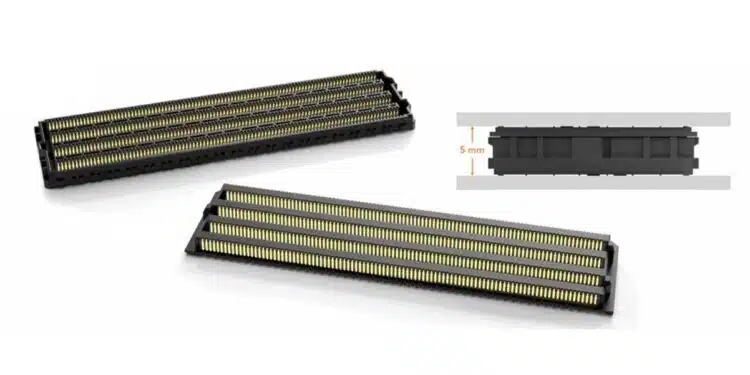Samtec is excited to introduce the newest members of its AcceleRate HP® high-performance array family: 800-position APM6, APF6 at a 5 mm stack height.
The AcceleRate HP® connector set delivers exceptional signal integrity performance and density (112 Gbps PAM4, 0.635 mm pitch). It’s an ideal solution for any system requiring extremely high data throughput in less space.
Applications include HPC (high-performance computing), AI (artificial intelligence), storage and networking.
Data rates are compatible with PCIe® 6.0, CXL® 3.2, and 100 GbE protocols. Protocol capability of Samtec connectors is calculated from a comparison of the protocol channel data rate and the Samtec Channel Performance Metric(CPM) per product.
The high 800-position pin count version of AcceleRate® HP has an 8-row x 100-position configuration, yet still manages to achieve a fairly compact footprint and an extremely low profile:
- Footprint: 68.62 mm x 18.20 mm (2.701″ x 0.717″)
- Profile: 5 mm stack height
A 10 mm stack height version at 800-positions is on the roadmap, with plans for release in Q2 2026.
Additional ADM6, ADF6 features include an impedance of 92.5 Ohm, a maximum current rating of 1.2 A (4 pins powered), maximum voltage rating of 150 VAC (212 VDC) and an open pin field array design allowing maximum grounding and routing flexibility.
Designed with performance and reliability in mind, APM6 and APF6 use Samtec’s solder column board termination technique (identified as -0 in the part callout). As interconnects continue to get smaller and redefine micro, solder joint reliability can become more challenging making solder application and processes part of the overall SI conversation. The solder column termination method enhances structural integrity and supports reliable electrical performance.
Solder Column Termination:
- Ideal for extremely dense, high-speed connectors
- Advanced structural integrity due to the column-like shape after reflow
- Efficient distribution of thermal stress, absorbs deflections
- IPC Class 3 compliant post solder joint
- SJR Tested per IPC-9701 with thermal exposure to -55 ˚C to 125 ˚C
- Excellent electrical performance































